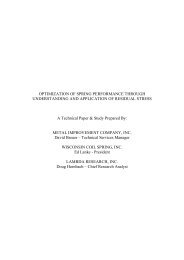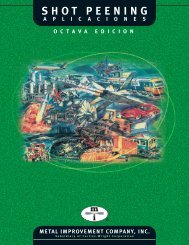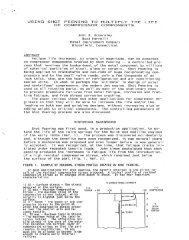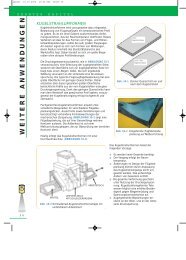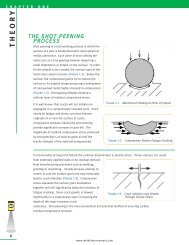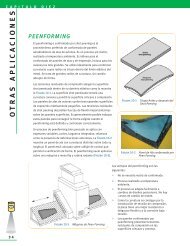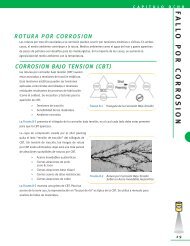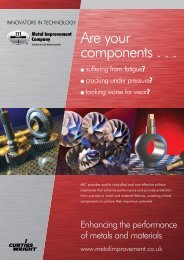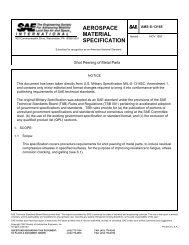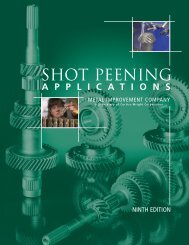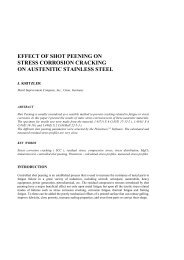Relaxation of Shot Peening Induced Residual Stresses in Ti-6Al-4V ...
Relaxation of Shot Peening Induced Residual Stresses in Ti-6Al-4V ...
Relaxation of Shot Peening Induced Residual Stresses in Ti-6Al-4V ...
You also want an ePaper? Increase the reach of your titles
YUMPU automatically turns print PDFs into web optimized ePapers that Google loves.
Crack growth predictions were term<strong>in</strong>ated at 10 7 cycles, which is consistent with the fatigue databases used <strong>in</strong> most<br />
turb<strong>in</strong>e eng<strong>in</strong>e designs.<br />
The author recognizes the limitations <strong>of</strong> the methods described above. However, s<strong>in</strong>ce the <strong>in</strong>tent <strong>of</strong> the<br />
current study is only to explore the potential for us<strong>in</strong>g shot peen<strong>in</strong>g <strong>in</strong>duced stresses importance <strong>of</strong> modest changes<br />
<strong>in</strong> peen<strong>in</strong>g <strong>in</strong>duced stress distributions on damage tolerant life, the above methods are viewed as be<strong>in</strong>g adequate to<br />
estimate the order <strong>of</strong> magnitude <strong>of</strong> peen<strong>in</strong>g <strong>in</strong>duced crack growth retardation and the impact <strong>of</strong> isothermal<br />
exposures.<br />
3. Results and discussion<br />
3.1 As peened residual stresses<br />
The residual stress distributions measured as functions <strong>of</strong> depth are shown graphically <strong>in</strong> Figures 1 and 2<br />
for the 6-9N and 6-8A <strong>in</strong>tensity peen<strong>in</strong>g conditions respectively. Compressive stresses are reported as negative<br />
values and tensile stresses as positive values. Trend l<strong>in</strong>es represent a cubic spl<strong>in</strong>e curve fit to the data and are<br />
<strong>in</strong>tended as a visual aid only. Three replications were made for each <strong>of</strong> the peen<strong>in</strong>g conditions to ascerta<strong>in</strong> what<br />
level <strong>of</strong> variability might be encountered <strong>in</strong> the residual stresses <strong>in</strong>duced by these peen<strong>in</strong>g configurations due to<br />
small variations <strong>in</strong> the peen<strong>in</strong>g process and material response.<br />
Additional surface only measurements were made on other coupons prior to their assigned isothermal<br />
exposures to further <strong>in</strong>vestigate the variability <strong>in</strong> the peen<strong>in</strong>g <strong>in</strong>duced stress states. These results are reported <strong>in</strong><br />
table 1. These surface only measurements are “raw” values and are not corrected for the penetration <strong>of</strong> the x-rays<br />
<strong>in</strong>to the stress gradient exist<strong>in</strong>g <strong>in</strong> the specimen. Precise corrections are not possible for surface only<br />
measurements, s<strong>in</strong>ce the exist<strong>in</strong>g stress gradient cannot be quantified without subsurface measurements.<br />
The surface stresses <strong>in</strong>duced by both the 6-9N and 6-8A peen<strong>in</strong>g conditions were extremely repeatable<br />
across all observations. In fact, based on the observations tabulated <strong>in</strong> Table 1 it can be concluded that the surface<br />
residual stresses associated with the 6-9N and 6-8A peen<strong>in</strong>g conditions are statistically identical. The<br />
ramifications <strong>of</strong> this f<strong>in</strong>d<strong>in</strong>g will be further explored <strong>in</strong> section 3.3.<br />
There were noticeable differences <strong>in</strong> the <strong>in</strong>-depth residual stresses observed among the different<br />
replications <strong>of</strong> the two peen<strong>in</strong>g conditions. (Figures 1 and 2) With only three replicates available per condition, it<br />
5



